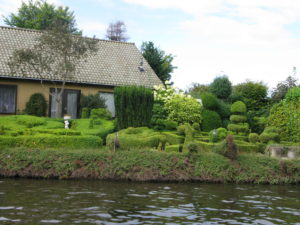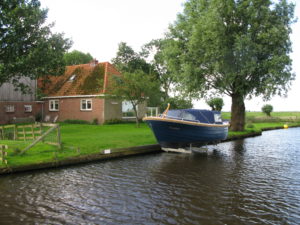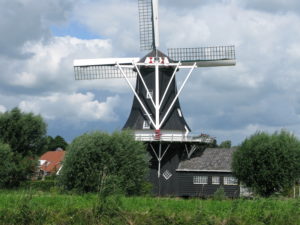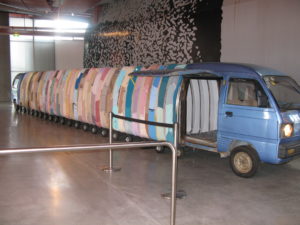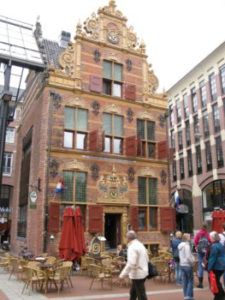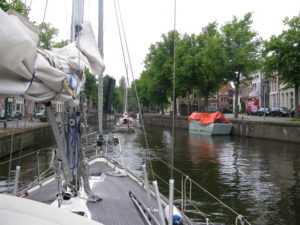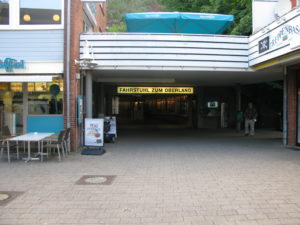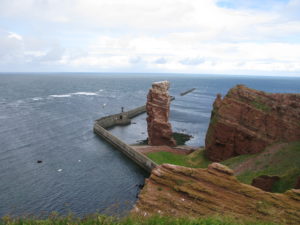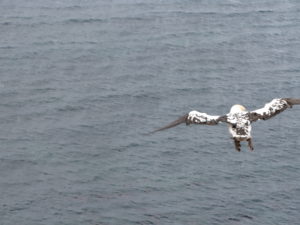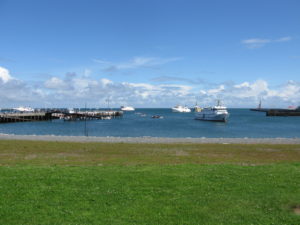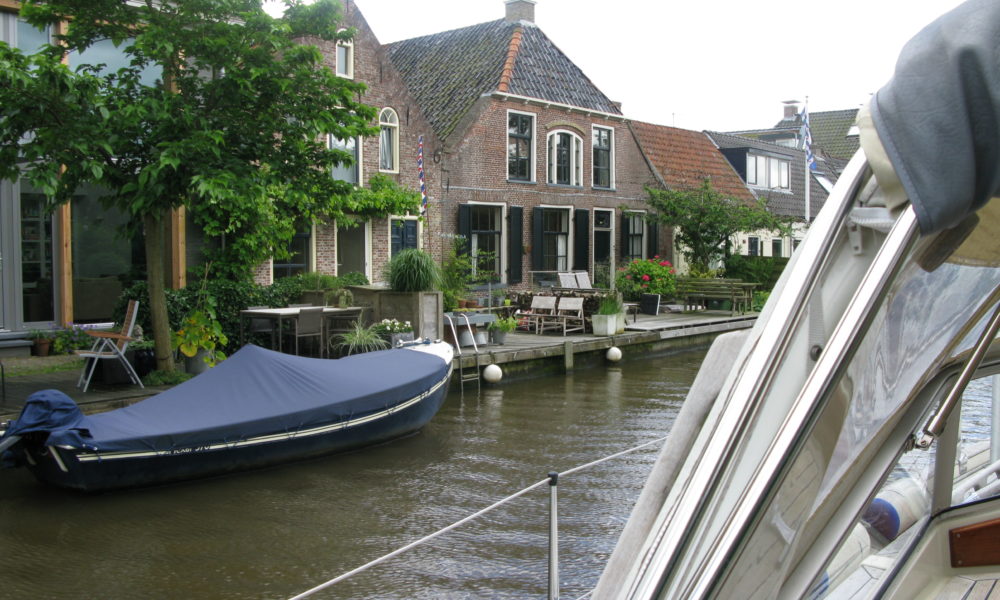
Sailing the Staande Mastroute in Holland
53° 19′ 51.6972” N 6° 55′ 28.056” E
After spending a few days on the German island Norderney we head towards Delfzilj. The city are chosen, because from here it is possible to sail “inside” Holland, through a system of channels, that you can pass with your mast still up.
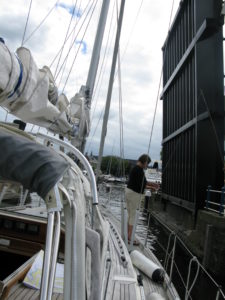
At some locks or bridges you pay a few euro in a wooden shoe from the end of a fishing rod
Five days – including two resting days – it took us to sail from Delfzilj to the great dutch lake called Ijselmeer. We passed 49 bridges and five locks. It worked perfectly. The bridges goes up, when we approach. As a rule. Sometimes we call via VHF. Some bridges charge a toll – five euro put in a wooden shoe, hanging from a fishing rod, which a bridge-employee lowers down towards us.
On our way we pass the one idyllic dutch town after another. The houses are located with manicured gardens facing the canal. The flowers are in full bloom, and on the edge a lot of boats are moored.
- In Holland you show your best to the waterside
- Every home has a boat
“Is it Ronja? Ronja from Thurø?”
52° 50′ 33.3672” N 5° 42′ 16.956” E
July 20, 2012
Fantastic day. Everything works. The bridges are opening. The rain obviously hold a bit back. And the waters are nothing short of exciting. Packed traffic. Cities that are architect-designed to let each home have its boat in the front yard. Channels crisscross. Lakes. Large and small. A tangle of intersecting ships. If we thought Denmark was a sailing nation, think again. Holland controls for game. Everything here is about sailing.
We find a port. Calm. Just outside Lemmer. We are checking out the town, and eat in the port restaurant. And we enjoy the most luxurious bathing facilities. Hot shower in six hours if desired.
Just before Lemmer we pass a Danish sailing yacht, sailing the opposite direction to us. Virtually everyone we meet are Dutch or Germans. But this guy yells: “Is it Ronja? Ronja from Thurø?” It turns out that they are themselves from the small harbour, Thurø Bund back home. “Hello there!” And then they are gone.
Everybody talks about the weather. In our port are many Germans. They are talking clearly about maybe going to Mallorca in stead of Lemmer.
Log book: Departure 9.00. Destination: Lemmer. Arrival: 13.00.
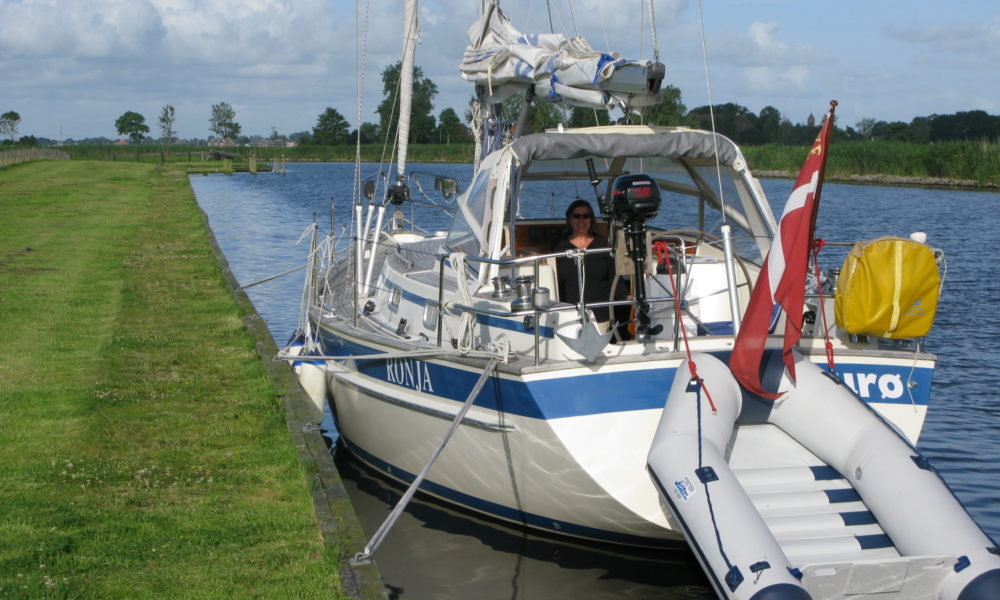
Bad day: Stupid lock guard, rain and Ronja hits the bottom of the canal
53° 13′ 37.4988” N 5° 49′ 1.452” E
July 19, 2012
Black day. Everything seems to be against us. We start with an argument with the gate guard at Willem Lorésluis. He lets the bridge dump down right in front of us. He thinks we are too slow to move towards bridge and lock. We blame him, that he only advertises his messages in Dutch. Angry talking over VHF.
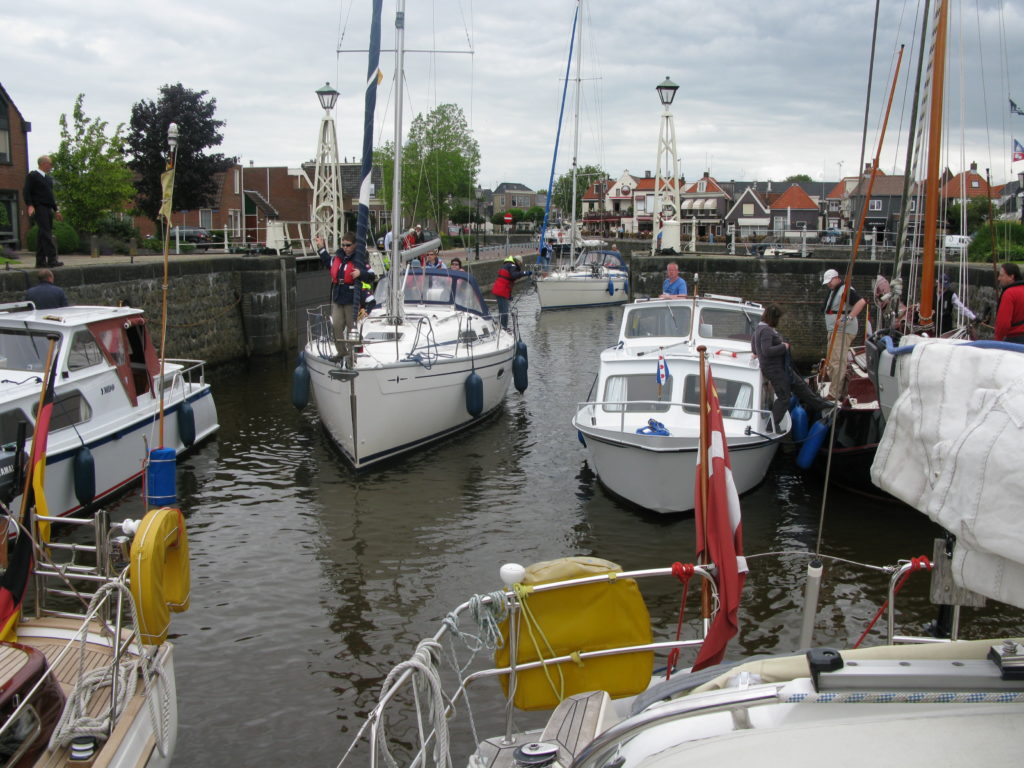
And so it goes throughout the day. We hit the lock guards’ lunch break, we hit their after work shift, and we spend two to three hours alone in waiting. Meanwhile the rain pours down and the wind is whipping, even here inside the country.
Thrilling is that our echo-sounder constantly shows 10-20-30 centimeters of water under the keel. And regularly 0 centimeters. Often – five times a day – we hit the bottom of the canal and are briefly stuck. Dutch channels are not designed for ships with a draught of 1.75 meters.
At 19 o’clock, we do not want to go further. We moor to a field with a small bulwark and rings. Sleeping deeply. One cow muh’s twice. A few geese squawk. The rest is silence. An enchanting calm and dream-filled night.
Log book: Sailed: 9.00. Destination: Leuwarden (approximately). Arrival: 19.00 in Wergea, south of Leuwarden.
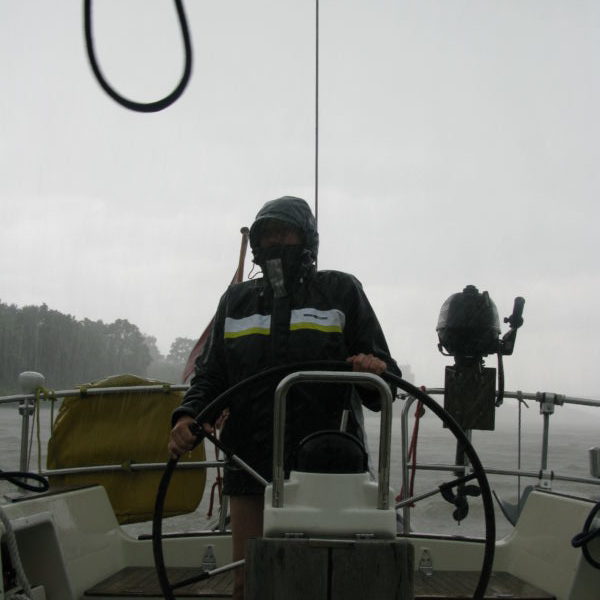
Canal boating in constant rain
53° 19′ 2.676” N 6° 9′ 58.3236” E
July 18, 2012
It takes a few hours to get through ten small bridges in Groningen. Actually ok. You approach the bridge, and then it opens. As a rule. A few times we have to call via VHF.
Unfortunately, both rain and wind are really beginning again and makes our trip somewhat sour. Occasionally, the storm is so strong that we make a stop at the shore until the worst wind is over. The anemometer shows wind speeds of 11, 12, 13 and 14 meters per second. Especially when we underway have to stick our noses into the Waddenzee for a few miles it feels dramatic.
At 16 o’clock we seek port. Large port but without life. Lunegat. The rain increases further.
Log book: Sailed 9.00. Destination: Leuwarden (approximately). Arrival 16:00 in Jachthaven Lunegat.
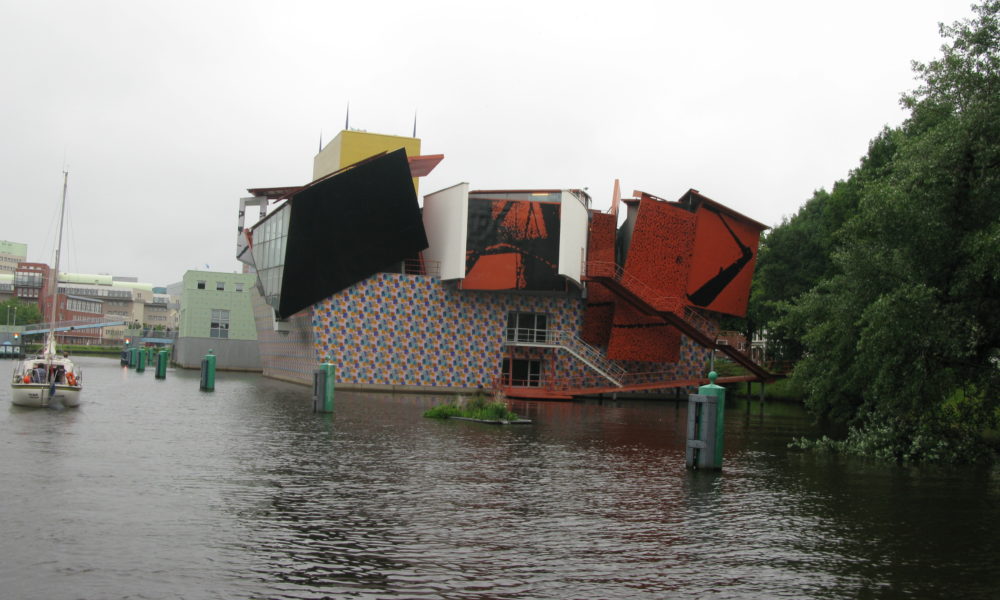
A stop over in Groningen. Super Town
53° 12′ 43.29” N 6° 34′ 13.4616” E
July 17, 2012
Jogging shoes on. We stay in Groningen an extra day and starts with a jog around Groningen’s central island, about 4 km.
The day we spend at a food market, a maritime museum and a great art museum. At the museum, “Groningen Museum”, we are especially excited about a Chinese installation artist Yin Xinzhen who make a single work of art at the same museum by Wei Wei seem unimaginative and boring.
The museum building itself is a mix of scandal and ingenious (see pictures).
We contacted Koos Stall (talented Dutch designer) and his wife, Magriet, to invite them to dinner at Ronja. But they were on summer holidays in their apartment in Berlin. They live only six kilometer from Groningen. Instead, we eat dinner at Ni hau, a Chinese restaurant with great food. Annoying however that monitors while we are eating show promotional videos for the whole Ni hau Group.
Groningen is a great city. Young, vibrant, energetic, alternative. Aarhus multiplied with two. A Danish girl studying at Groningen University, confirms with enthusiasm, that it is a more than commonly lovely city.
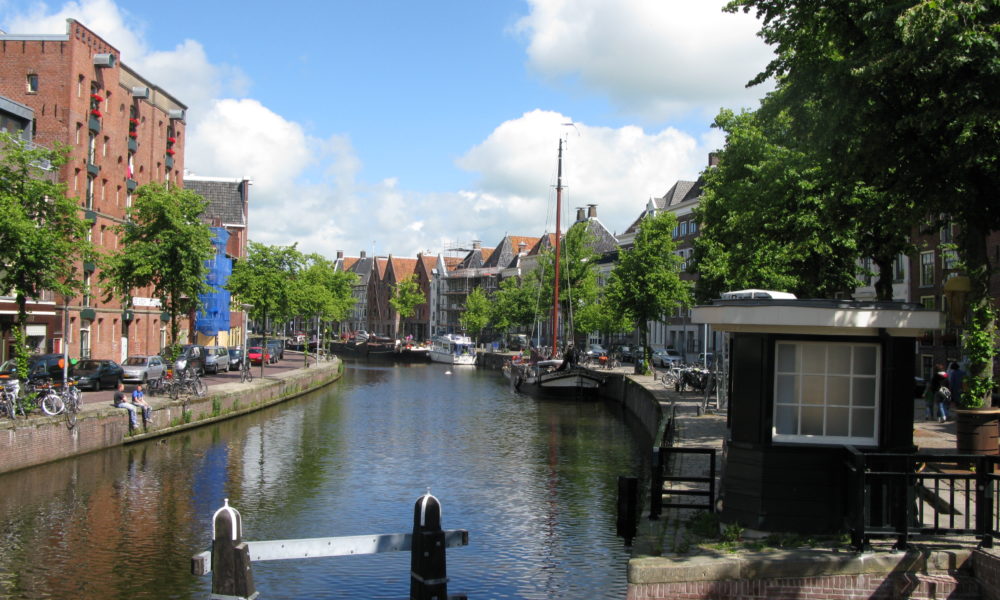
Groningen is a wonderfully varied city
53° 12′ 43.29” N 6° 34′ 13.4616” E
July 16, 2012
The lock in Delfzijl lowers us a meter, maybe one and a half. In front of us lies Ems Canal. 26 km straight, dug channel through agricultural land. The logistics are formidable. We pass eight bridges with virtually no latency. The bridges just goes up, when we approach.
In Groningen we turn into Oesterhaven, a marina right ind the middle of the city. For the first time with a formidable port master, that is ready with a megaphone to guide us into a proper berth.
Groningen is a wonderfully varied city. Old and new. Large and international. Young and alternative. 20,000 college students put a mark on the townscape. One senses that Holland even more than Denmark has been oriented towards international trade and travel. A maritime nation, that has channeled all sorts of peoples back to Holland and managed (?) to integrate them. Well, we see of course only the surface.
We get an impression of the city, and decides to have an extra day in Groningen. It is a bit like our old berth in Christianshavn canal, Copenhagen. Harbour-cruisers sail past and we hear guides explain, what the tourists see.
The weather is solid. Rain, rain, rain, rain.
Log-book: Sailed at 10:00. Destination Groningen. Arrival 13:00. Weather: So much wind, that we think: Lucky we are not out on the open sea today. Southwest 11 and up meters / second.
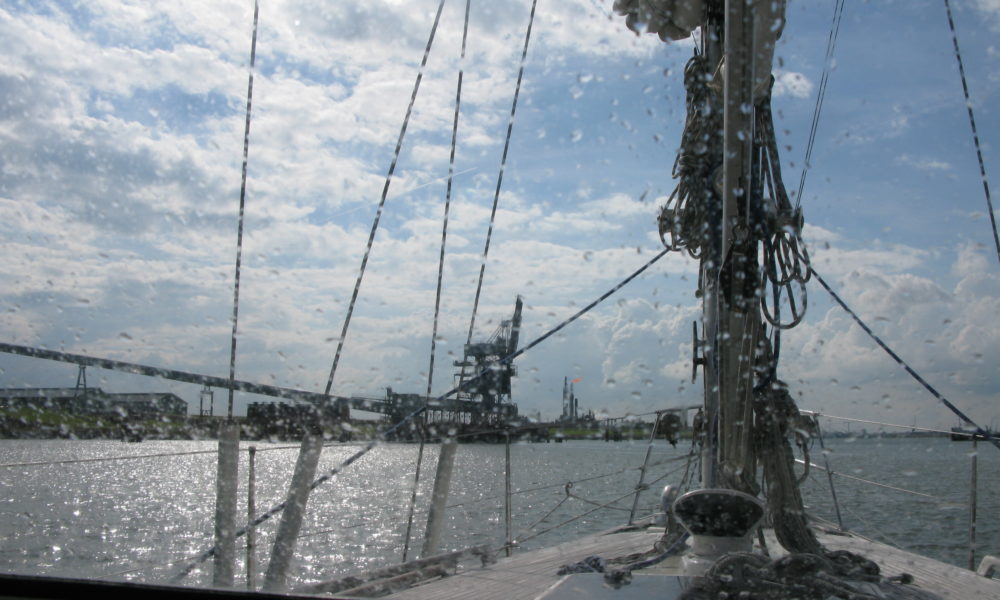
Still we do not understand the tide completely
53° 19′ 48.864” N 6° 55′ 51.1176” E
July 15, 2012
Up at six o’clock. Immediately we start. We follow Jörg’s advice. Beautiful morning. Even with small pieces of blue and glimpses of the sun. But the wind is again contrary, and waves are higher than we know from home.
We are – mildly speaking – uneasy in the sea. We have to pull op the main sail to stabilise the boat’s movements. Per would like to go on deck and hoist the sail, but Kirsten insists that it’s her job. She believes, that the chances are greater, that Per can save her from the water, if she falls, than for her to save Per.
Jörg’s schedule does not hold at all. It takes us six hours to reach Borkum, not four. In addition it takes a few hours to round this island, and we completely misses the tidal push in the Ems river, which should have given us an extra four knots on our way to dutch city Delfzijl.
Ems River is depressingly sad. Huge power plants dominates the entrance. And with no other boats on the water all seems desolate and bleak. Add to this the constantly gray weather.
On a “plaat”, as the Dutch call the surfaces exposed when the tide recedes, we see a seal. Further along the same plaat are a bunch of tourists boarding a ship after having been on a Wadden Sea tour.
Tide is a strange phenomenon. Now we have sailed in it for a week, and we still do not understand it completely, despite practical experience and tons of tidal informations.
But it is no longer quite the mystery, that it was before, we set keel into it for the first time.
Our first observation is, that you can avoid it at a great lenght. If you consciously opt the areas being reclaimed and ensures, that the depth even at low tide is ok, then only remains the question of getting more or less push out of the tide. The one and a half knots with or against, that we have known at home in Danish Svendborgsund may well in these waters be four knobs counter or co-current flow. It can turn into an advantage, and it can turn into a disadvantage.
Our second observation is that certainty about the current status of high tide or low tide can make it possible for you to pass areas where you otherwise would think: “Damn it! Here is not deep enough.” Proper planning gives you opportunities. Jörg gave us a copy of the program “wxtide47” that graphically tells you, where you at a given location are in the tidal cycle.
Our third observation is, that both the Germans and the Dutch have developed amazing engineering skills in creating tidal ports where pontoons rolls up the barrows, telephone pole-like pillars, and you can sleep sweetly, while water moves both two, three, four or more meters up and down below you.
Our fourth observation is more of an assertion: It does not matter if you get stuck on the ground, because if the tide is with you, eventually it will set you free again.
Delfzijl is a pure, unadulterated industrial city. But the city’s marina, Neptunus, is prima. We sleep well after 12 hours in the high waves.
Log-book: Sailed 6.00. Destination: Delfzijl in the Netherlands. Arrival 18:00. Weather: Wind from the west 10 meters per second. Almost contrary to our sailing direction. Big waves. Hammering up and down. Tiring sailing.
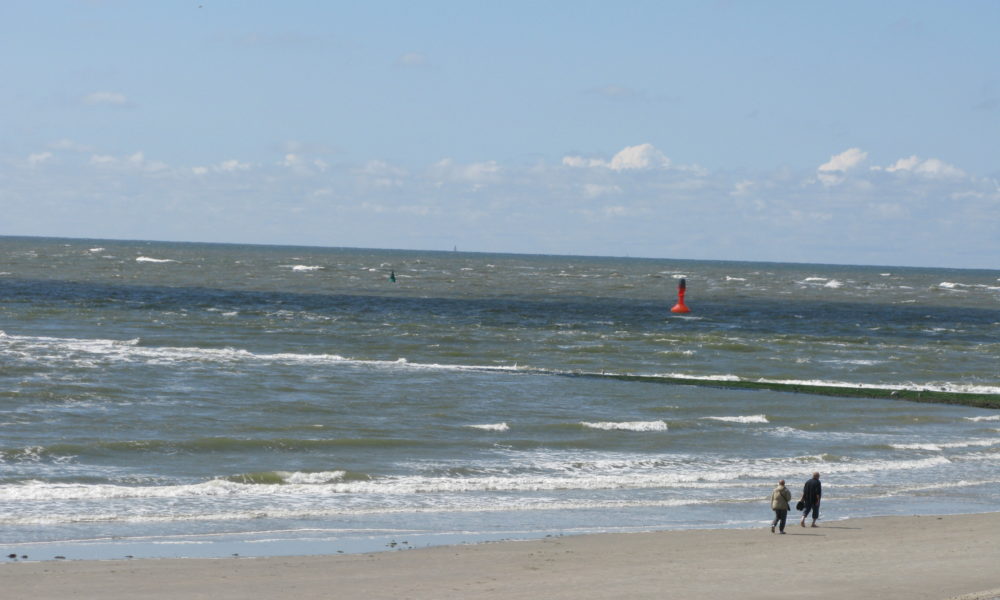
An interesting German spa- and wellness town
53° 42′ 8.3736” N 7° 9′ 56.6208” E
July 14, 2013
We are in Norderney. We are jogging seven kilometers in the town to get a sense of where we’ve arrived.
A spa town. Huge. Almost an industry. Hundreds of hotels and boarding houses, parks, cafes and a waterfront, which is powerful like the North Sea in Denmark. Very neat, very stylish, very beautiful and very subdued. This is apparently how the Germans have cure-vacation.
Back on the boat we do some cleaning. Later we cycle to town to shop. Falling into conversation with the owner of the neighboring boat, Jörg from Cologne, which has his Nauticat 33 lying in Ijselmeer and who knows the tidal waters and the Frisian Islands in and out.
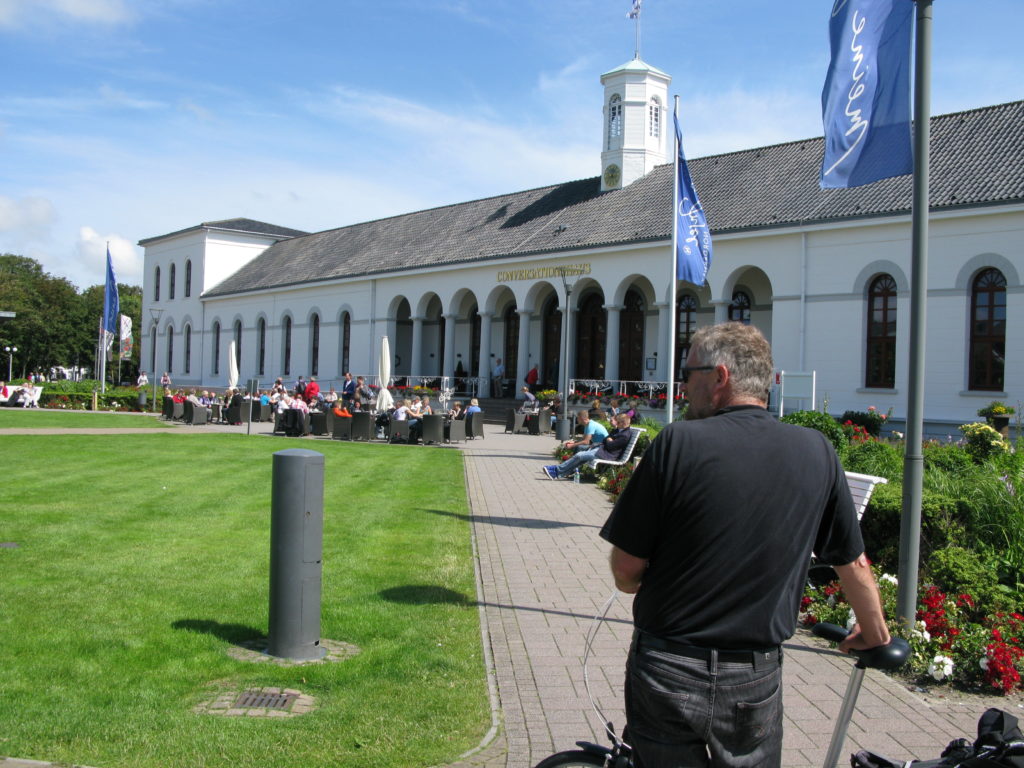
The tips pours out of him. About tides, how to sail in the Wadden Sea, good advice on different cities, and advice on how to put up the boat up for the winter near Amsterdam.
He gives us some charts, a tide application for our computer and an auto map of the entire Netherlands. Good stuff.
“You have to leave at six o’clock in the morning,” he counsels us, looking at the tide-tabels. Damn! We were intending to sleep late tomorrow.
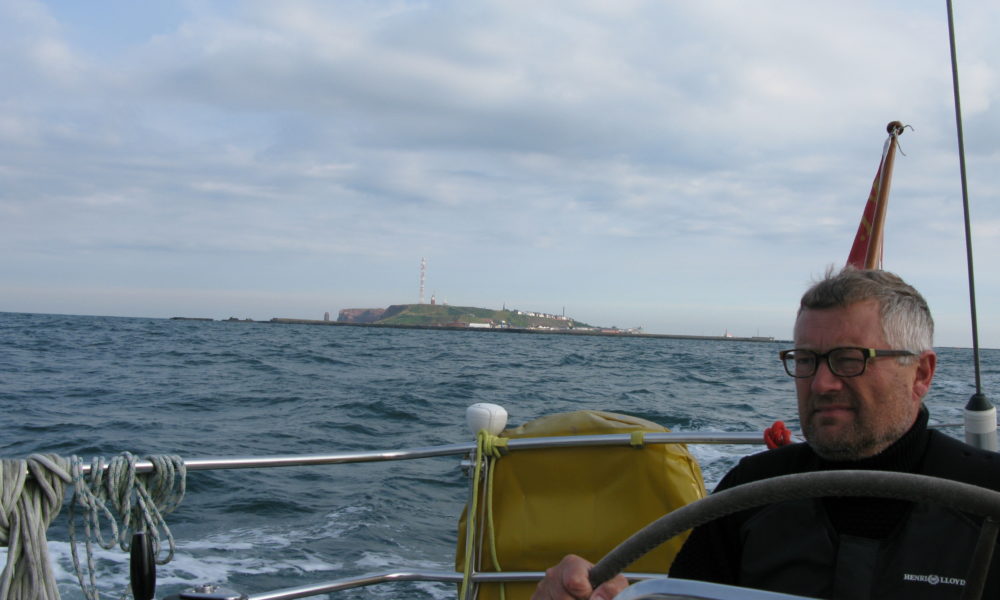
“Hold up” at sea. The police boards our boat and gives us a fine
53° 42′ 8.3748” N 7° 9′ 56.6201” E
Tuesday – July 13, 2012
Friday we decide to leave Helgoland heading for the Frisian island, Norderney.
The wind is against us again. But the weather forecast raised the prospect, that the wind will gradually turn during the day, and with the expectation of this we hoist the mainsail in the harbour of Helgoland, and then using the engine with the mainsail as stabilizing support sails we are ready to let the sail take over when the wind shifts.
We should not have done this.
The direct course towards Norderney brought us through not just one but two traffic separation zones, deep-water routes for large tankers and container ships. One for the river Jade, one for the river Elbe.
There was barely a ship in sight, those few who were, we knew exactly where were, so we “crossed” into the zone instead of taking the perscribed angle of 90 degrees. When such a zone is up to 10 km wide, you win both time and comfort by setting the direction after the wind and the goal instead of the regulations.
We should not at all have done this.
Far out on the horizon, we saw something that resembles a coastguard ship. When we saw it we turned on the VHF on channel 16 in order to hear any messages.
After a while, it looked as if the coastguard-ship had put a small boat in the water, and that this boat was heading towards us.
Damn it! There was no doubt. A high-speed inflatable boat was heading directly toward us. We turned Ronja into the wind, turned off the propellars and let the mainsail flap in the wind.
Shortly after, we were invoked. Four burly policemen in the dinghy. They let us understand, that they wanted to get on board. Very jovially. They joked that they needed lunch and slapped their stomachs.
It was not much about lunch. Two officers boarded Ronja. With pistols in their belts and a binder with forms and papers under the arm.
“We would like to explain why we are here,” they said. That is, the one spoke. The other took notes. “But first we’d like to see some documents – your passport, VHF license, proof of sailing education, nationality proof and evidence of ownership of the vessel.”
Luckily we had our documents under control, and when they subsequently asked for our charts, these were also OK. All charts were from 2012.
“We are here because we have observed, that you have crossed a traffic zone at an angle that differs 30 degrees from the rules of the sea,” said the officer.
He was absolutely right. We knew this in advance, and as if this were not enough, he brought a radar printout from the coastguard ship, where people apparently had followed us for a long time. “Here’s your course,” he said. “We called you on VHF pm. 10:32, but you did not answer”. This was before we turned the VHF on.
However this was only one thing. Then came the second. “We can look at course stability, that you both have had sails up and the engine on … It is only allowed under maritime law, if you with an inverted cone hoisted half up the mast shows that you are a sailing ship that is currently propelled to power” .
“Do you have a cone on board?” asked the officer.
“Certainly,” answered Per. “It is in the starboard bench.”
“Then you must draw it up now,” insisted the officer.
“Can’t we just take down the sail, so we are only motoring?”
“Your decision,” said the officer. And down came the sail.
“You have violated two rules. You will through your own authorities receive a fixed penalty notice of two or three hundred Euros. ”
Kirsten said that they should rather have said yes to get the lunch, which they themselves had proposed before they boarded us. The officers laughed politely and declined the offer. On the whole they were pretty professional. They did not go into discussions whether there had been any danger or any ships at all in the vicinity. They only focused on the fact, that two rules were violated.
They said goodbye and wished us a good journey, as they boarded their dinghy.
“Fucking German bureaucrats,” snorted Kirsten, when they were sailing away. “It is similar to getting a fine for ignoring a red light at a pedestrian crossing in the middle of the night, after having ensured that there is absolutely no traffic.”
Per was more relaxed over the incident. “We did something, we should not have done.” In his opinion, it was a fun and interesting experience.
The experience has led Kirsten, every time she sees a vessel that looks like a coastguard ship, to get a nervous twitch and to ask Per, if what we’re doing at the moment is actually completely legal.
After 12 hours rather good sailing – also with both sails up – we arrived in Norderney.
Log-book: Start of sailing 8.00. Destination: Norderney. Arrival 17.00.
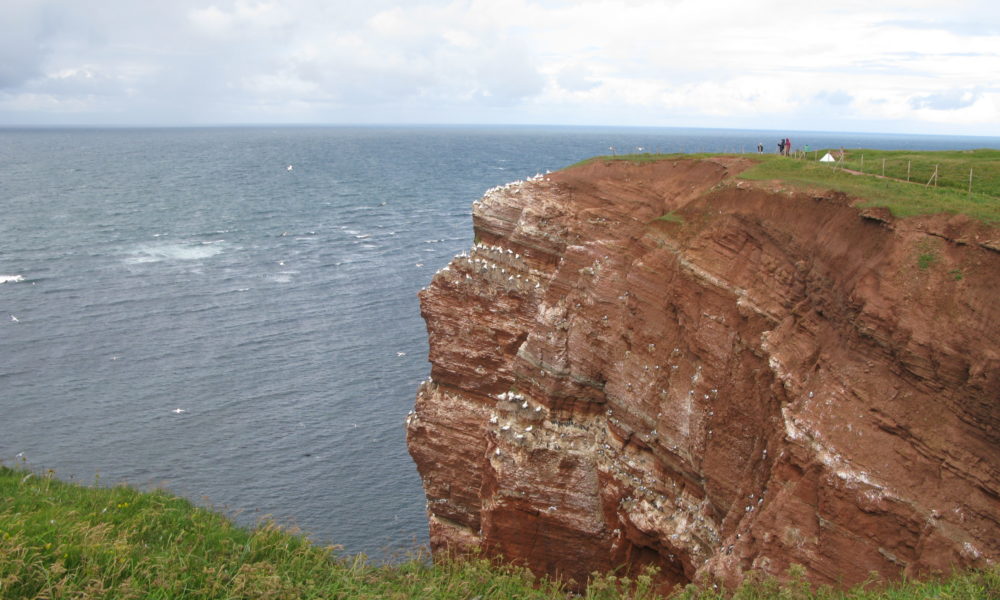
The wind howls. The rain splashes. We take an extra day at Helgoland
54° 10′ 33.3510” N 7° 53′ 38.1156” E
July 12, 2012
The wind howls. The rain splashes. The wind direction is counter to the direction we intend to go. We decide to spend the day on Helgoland.
In a gap between two rain-bursts we head to wander around the island. Interesting trip. Along the way, posters explain about the island’s history. Dramatic fighting between England and Germany on the ownership of the island. We also see gulls, guillemots and a lot of other birds, who lie windswept on shelves in the rocks.
Everything is, understood, in the German manner. Paths, paved with fences on both sides and especially landscaped vantage points. Not like in Anholt in Denmark with complete freedom to move anywhere you please.
But it’s still OK. Informative. Beautifull. Wind-blown. Very different.
